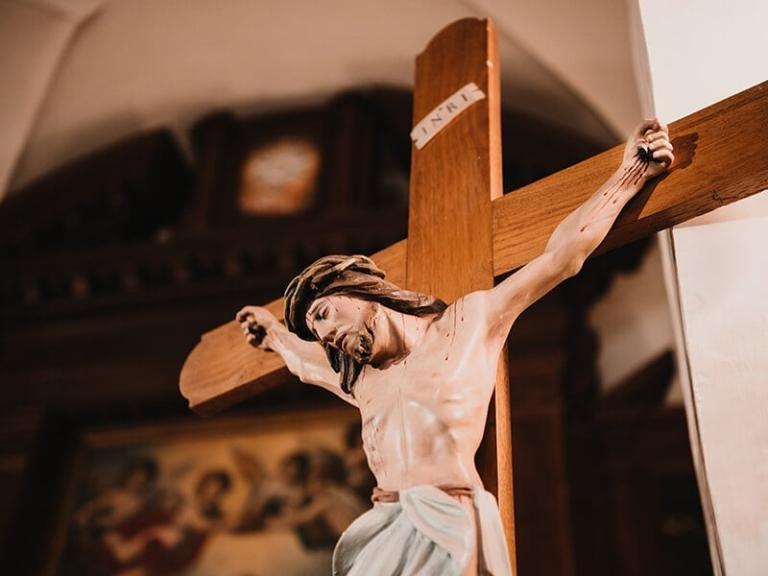 Christ died for your sins. This is not a shocking or problematic statement for nearly all churches today. Preacher and priests say it as though it was a historical fact, the bible “clearly” says that Christ died in order to pay the debt for our sins, no ifs and or buts. This means that we are to praise and adore him for doing this selfish act and saving such unworthy souls as our own.
Christ died for your sins. This is not a shocking or problematic statement for nearly all churches today. Preacher and priests say it as though it was a historical fact, the bible “clearly” says that Christ died in order to pay the debt for our sins, no ifs and or buts. This means that we are to praise and adore him for doing this selfish act and saving such unworthy souls as our own.
As church members we relive this reality weekly, singing songs about how we could never be with God for eternity if He had not sent his son to die a gruesome death for in our place. All the torment of hell was felt on that cross, we hear, poor blameless Jesus, suffering for those so stained by Satan’s power. Again, none of that is seen as controversial. Not in mainline protestant denominations, by the evangelical churches, or in Catholicism. But what if these narratives were only one way of approaching the cross? What if the idea of Christ suffering to atonement for humanity’s sins furthered our inability to support victims? And how would reimagining atonement through the cross potentially transform the way we saw Christ, salvation, and interpersonal violence.
Theories of Atonement
In order to you understand why we see the statement that Christ died in order to atone for our sins, giving us entrance into heaven without having to earn our way, we first have to look at the history of this theory and its development. Like so many aspects of Christianity the idea that Christ died to pay for our sins it’s not something that Christ said himself. It is one theoretical framework that developed in the first few centuries of the church and simply by consensus became seen as doctrine and opposing viewpoints as heresy.
Some of the most common theories for the purpose of the cross and its place in the conversation on atonement include Satisfaction Theory, Moral Influence Theory, Penal Substitution, Ransom Theory, Christus Victor Theory, Governmental Theory, and Scapegoat Theory (Finlan, 2011, Peters, 2005). In this list of theoretical frameworks exist the category of Substitutionary Atonement (SA). SA provides an umbrella for theories that focus on humanity having a debt to God and/or Satan and Christ dying in order to pay that debt. Under this umbrella fit Satisfaction Theory, Penal Substitution, Ransom Theory and Governmental Theory (Rohr 2019). Some would place Christus Victor there as well but I will explain my argument for why I do not see it as a part of the SA family.
Substitutionary Atonement requires there to be a triad relationship between the debtor, the creditor, and a sacrifice that will satisfy the price set. In Satisfaction and Penal Substitution Theory, the creditor is God, the indebted humanity, and the price set is either death or suffering plus death. Saint Anselm of Canterbury, a 12th Century Italian monk came up with Satisfaction Theory, stating that Christ’s death was the price that had to be paid in order to satisfy God’s anger at human sin.
During the Reformation, theologians such as Luther and Calvin took Anselm’s theory and add that it was not simply death that could satisfy God but suffering. Therefore, God sent his son to suffer horrifically and through this suffering die and by these things added together the divine balance could be written off the sin ledger. Ransom Theory was formed from Saint Origen, an Orthodox priest who lived in Alexandria in the 1st and 2nd centuries AD (Moore n.d.). St. Origen believed that Adam and Eve sold humanity to Satan through their sin and thus the creditor is not God but the Devil himself. In Ransom Theory Christ’s death is offered as ransom for the hostages/debtors which is humanity. God and Jesus team up to trick the devil into thinking Jesus will stay dead and thus free humanity while pulling a bait and switch on the devil.
Last under the SA umbrella is Governmental Theory. This theory is often held by churches in the Wesleyan tradition. It focuses on the suffering of Christ but not that the suffering was at equal measure with what humanity deserves, but instead that it was a smaller version of what the sinner would have felt but that it was enough to satisfy the debt to God. The other large difference in Governmental theory is that it states that the salvation is for the church, not people themselves. In order to be part of this salvation, individuals need to be members of the body of the church.
Slightly outside of SA exists Moral Influence Theory, which originates with St. Augustine in the 4th century AD. This atonement theory does not have the same system of debt and creditor but instead focuses on Christ’s life, vs his death, as the way to salvation. By living an exemplary life Christ set us free from the chains of sin, his death was simply part of living in order to defeat evil through his example and resurrection. Next under the moral influence umbrella is Recapitulation Atonement Theory (Hollen 2015). Recapitulation is the theory that the evolution of a creation itself can be undone and improved. This atonement theory comes from Irenaeus of Lyons, a theologian from Smyrna in 130 AD. Irenaeus stated that Christ’s death was a culmination of a life lived to correct the mistakes made in the Garden of Eden. Where Adam and Eve were immature and impatient, according to Irenaeus, Christ was wise and foreseeing. Therefore it was not Christ’s death itself that set humanity free but his righteous living.
Christus Victor Theory, created by Gustaf Aulén in 1930, aligns with Moral Influence in that the focus is on defeating evil through the resurrection, not on paying a debt. Christos Victor is sometimes paired with one of the SA theories but because it innately focuses on a system that exists outside of debtors and creditors I believe that it deserves to be viewed separately.
All of the aforementioned theories ask us to place Christ’s life and testimony on the platform of guilt and shame. We must follow Christ to benefit from the one act, one individual that could bear such pain as to make as admissible into God’s kingdom. Scapegoat Theory changes this paradigm. In Scapegoat theory there is not only no debtor or creditor, there is no debt. The violence of the cross is never positioned as virtuous, redemptive, or holy. Christ is not seen as a sacrifice but as a victim (at the resurrection a survivor) or the evil that exists in the world. This theory comes from Rene Girard’s work on mimetic violence (Girard, 1996). Mimetic violence being violence that bonds two enemies through acting out their frustrations at each other on a third innocent party. The innocent person/people are used as a symbol for the underlying conflict, though they have no actual role in it, and by harming the innocent party the two groups who are the actual actors of harm feel that the issue has been satisfied. Modern examples of this include blaming Jews, homosexuals, and the disabled for Germany’s economic plight following World War 1. The same is true for the lynches in the southern United states against the Black community after the Civil War and in the suburbs during Regan’s war on drugs. A named “enemy,” no matter how innocent, provides a scapegoat from responsibility and accountability for the actual problem. Christ’s death was therefore an act of violence on an innocent man. Jesus’s example therefore points to our lived responsibility, through all generations, to see the harm we are causing and to form a relatability between God and their people’s suffering (Kailey 2008 pg. 3).
The Cross as Gender-Based Violence
When we look at the cross and Christ’s sentence to crucifixion we must examine how gender has played its part in both the theories that surround atonement and Christ’s own gender expression.
In recent decades a number of theologians have remarked at how substitutionary atonement theories impact victimology in the church. The idea that Christ, as God’s other half/third, was told to suffer and die at the will of the dominant partner in the trinity has been grounded in victim-blaming and spiritual abuse across denominations. If Christ was perfect and thus willing to do what he was told for the good of humanity then a victim of abuse, particularly at the hands of those put “in charge” of him/her/them should be a willing sacrifice. This framework is then used to justify domestic violence, sexual assault, and child abuse. A husband may have to discipline his wife, then will sacrifice to her own safety and needs. A husband may live with and psychologically abusive partner because he must be the willing sacrifice for his marriage and family wellbeing. One partner must submit to the other’s sexual needs no matter how absent consent is in the moment, as they have been told they consented in their vows and have to sacrificially obey henceforth. Children are the most vulnerable to this logic as Christ was the son of a father who demanded full obedience.
All of these examples intersect with the field of gender-based violence. Gender-based violence (GBD) is defined as any form of interpersonal violence that is informed and justified based on gender norms and expectations. This includes not only for violence against women, as it is most commonly used in relation to, but also violence against people of any gender who do not conform to social gender expectations (Wirtz 2020). In the field of Title IX, the federal law that protects against gender-based discrimination and barrier which decrease access to educational opportunities, both students with disabilities and those who belong to the LGBTQ community have used the law to support that the violence they experienced was not from being female but from not conforming with gender constructs (Lew 2018 & Lopez v. Metropolitan Government of Nashville 2009).
Jesus was, in many ways, gender non-conforming. As a cisgender man living under Roman occupation in ancient Israel he did not conform with almost any of the gender norms of his time. He belonged to a world that rarely saw men not marry, yet we see evidence of his lifelong single status, just like his fellow Jewish prophet Jeremiah. Though rabbis were known to teach children and counsel women followers, Christ’s example in welcoming children and teaching women as a cornerstone of his ministry was unusual at best. All of this would have made him additionally hated and targeted for violence.
To say that God demanded, or even simply desired, that Christ die in order to appease the sin of the world can be viewed differently if we include the lens of gender non-conformity. Since Christ was not a participant in what we would call toxic masculinity, we can see how the connection between violence against those in a lower status than another is further affirmed in substitutionary atonement theories. Jesus’ gentle and nurturing nature feminizes him in many ways. His status as eternally a son infantilizes his role in relationship to God. How easy it is then to make a connection between mistreating a spouse or child who are supposed to be submissive (according to doctrine/culture) and using Christ as the example for demanding their compliance.
Scapegoat Atonement theory turns this all on its head. If Christ is the victim of social injustices, if the violence he experienced was at the hand of those abusing their power and taking out their frustrations on he who would not defend himself then how differently we are called to view the victim experience.
Substitutionary Atonement and Childism
The crucifixion and its related atonement theories must not only be viewed in the light of Christ as the leader of the movement that became Christianity but as an intersectional human being. Part of these intersecting identities is his experience as the divine child. No matter how Christ ages in the gospels he is always a son and never a father. This reality leads us to examine how childism impacts the way that we view the cross.
Childism is defined as “The automatic assumption of superiority of any adult over any child; results in the adults needs, desires, hopes, and fears one question president over those of a child” (Pierce 1975 pg. 1). Childism is found in multiple aspects of the American culture from our legal system trying children as adults, to child discipline in schools, and the way we view child abuse and custody cases (Wall 2019).
The idea that a child automatically has less rights because of their age in relation to their caregivers is a form of prejudice that can be viewed as on par with other forms of systemic oppression. A child can be harassed, insulted, beaten, or sexually abused and have the systems around them right the experience of as inconsequential. If those exact same actions were committed against an adult all sorts of legal and social action would be taken. Why we think that children feel any less physical or emotional pain is rooted in cultural norms that created myths about childhood resiliency and memory as if it did not impact them the same way as it would a person who had lived longer on the planet.
Though Christ demonstrates that he is an autonomous being with agency and leadership his story is always contained in that of being a minor. This dynamic then bleeds into how we view his atonement. If Jesus was but an eternal child who was forced to suffer to please his parent in order to save his siblings then the cross is child-abuse (Brock pg.157).
In her book, Proverbs of ashes: violence, redemptive suffering, and the search for what saves us, Rita Nakashima Brock tells the reader of a sermon that helped her explain her rational for claiming that substitutionary atonement is in fact a theory for abuse justification.
“Offense at a cruel image of God has been present throughout the centuries. In in his Treatise on the Atonement, the American Universalist preacher Hosea Ballou said, ‘The belief that the great Jehovah was o ff ended with his creatures to that degree, that nothing but the death of Christ, or the endless misery of mankind, could appease his anger, is an idea that has done more injury to the Christian religion than the writings of all its opposers, for many centuries. The error has been fatal to the life and spirit of the religion of Christ in our world; all those principles which are to be dreaded by men have been believed to exist in God, and professors have been molded into the image of their Deity, and become more cruel. . . .’ ‘‘Do we really believe that God is appeased by cruelty, and wants nothing more than our obedience? It becomes imperative that we ask this question when we examine how theology sanctions human cruelty. ‘‘If God is imagined as a fatherly torturer, earthly parents are also justified, perhaps even required, to teach through violence. Children are instructed to understand their submission to pain as a form of love. Behind closed doors, in our own community, spouses and children are battered by abusers who justify their actions as necessary, loving discipline. ‘I only hit her because I love her.’ ‘I’m doing this for your own good.’ The child or the spouse who believes that obedience is what God wants may put up with physical or sexual abuse in an e ff ort to be a good Christian. ‘‘Theology that defines virtue as obedience to God suppresses the virtue of revolt. A woman being battered by her husband will be counseled to be obedient, as Jesus was to God. After all, Eve brought sin into the world by her disobedience. A good woman submits to her husband as he submits to God (pg. 41-42).”
God is a relational God. God is love. A loving parental relationship that is grounded in what we now recognize as neurologically healthy parenting practices would never condone nor demand ritualistic abuse to appease a parent. Substitutionary atonement supports and justifies abuse of children and all other vulnerable people. It is a reflection of the oppressive eras and cultures that is was born from, not the objective truth. If we want to create faith systems that support survivors we have to look at violence against the innocent as what it is- the antithesis of God’s kingdom.
Scapegoat Atonement Theory and Victimology
Scapegoat Theory reveals to us an atonement theory that is completely free from the other victim-blaming paradigms. Instead of a God that demand sacrifice through victimizing their own child we see that the only cause of the violence at the cross is the perpetrators of violence- humanity. Christ is innocent and the suffering he experiences only points out how victims are blameless and how cruel our world can be to those who least deserve it. Scapegoat theory leaves no room to justify violence through a higher purpose. While God worked this inexcusable cruelty together for good- in showing us a pathway forward away from our human inclination towards blaming the innocent and perpetuating harm- this is the good that God was able to reframe out of evil, not evil that was designed for good.
This focus is not simply a nice idea, it is crucial to uphold if we desire to create a faith the abhors harm and protects victims. A faith community that preaches that sometimes people have to suffer for the greater good they affirm perpetrators of violence as having a religious rationale for their actions. In order to create truly safe environments for survivors, we must reimagine the ways that we have been fed narratives about atonement, the cultures and norms they were born from, and construct a new perspective of the cross. As Brock writes in Proverbs of Ashes,
When the Christian tradition represents Jesus’ death as foreordained by God, as necessary to the divine plan for salvation, and as obediently accepted by Jesus the Son out of love for God the Father, God is made into a child abuser or a bystander to violence against his own child. The seal of abuse is placed on their relationship when they are made into a unity of being. If the two are one, Jesus can be selfless, can give himself totally to God, a willing lamb to slaughter. I thought of this system as cosmic child abuse… When the Christian tradition represents Jesus’ death as foreordained by God, as necessary to the divine plan for salvation, and as obediently accepted by Jesus the Son out of love for God the Father, God is made into a child abuser or a bystander to violence against his own child. The seal of abuse is placed on their relationship when they are made into a unity of being. If the two are one, Jesus can be selfless, can give himself totally to God, a willing lamb to slaughter. I thought of this system as cosmic child abuse (pg. 156-157).
Moving away from substitutionary atonement not only changes the way children and domestic violence victims are seen but in the ways that we examine our complicity with hate crimes. In his groundbreaking book, Jesus and the Lynching Tree, Cone places the cross in the same experiences as the lynching of Black bodies in the southern United States. He explores our desire to sanitize the brutality of crucifixion in order to minimize the suffering of the oppressed in our world today.
While the lynching tree is rarely discussed or depicted, the cross is one of the most visible symbols of America’s Christian origins. Any Christians embrace the conviction that Jesus died on the cross. To redeem humankind from sin. Taking Our Pl., Jesus suffered on the cross and gave “his life a ransom for many (Mark 10:45).” We are “now justified by God’s grace as a gift through the redemption that Christ Jesus God put forward as a sacrifice of atonement by his blood affective through faith (Romans 3:24-25)”. The cross is the symbol of the Christian narrative of salvation.
Unfortunately, during the course of 2000 years of Christian history, this symbol of salvation has been detach from any reference the ongoing suffering oppression of human beings those whom Ignacio Ellacuria, the Salvadoran martyr called “the crucified peoples of history.” The cross has been transformed into a harmless not offensive ornament that Christians wear around their necks rather than reminding us of the cost of discipleship has become a form of cheap grace an easy way to salvation that doesn’t force us to confront the power of Christ message and mission. Until we can see the cross and the lynching tree together, until we can identify Christ with a re-crucified black body hanging from a lynching tree, there could be no genuine understanding of Christian identity in America, and no deliverance from the brutal legacy of slavery and white supremacy (pg. xiv & xv).
Cone continues in chapter two to depict the cross’ centrality in Black churches as a symbol for resistance against the violence people of color experience and an experience the brings communion between the oppressed and their Lord. He states that “Just as Jesus did not serve to suffer, they knew they did not deserve it…(pg. 22).” It is in understanding that the freeing, ransoming, liberation from sin was not our personal sins that forced God to find a worthy sacrifice but from the collective sin of interpersonal violence and oppressive actions. The cost of Christ’s life was to show humanity just how injustice we can be to one another and to be liberated from victim-blaming. In this paradigm, the marginalized and victimized meet a God who is always attuned to the suffering of his children, who blames none of those caught in the plight of systemic inequality but suffers alongside them and who fights against tyranny.
Christ as Survivor
Christianity is an unusual religion. It centralizes a messenger of God whose life revolves around the least important people of the era the suffering caused by a cruel world. The central figure is a divine being who struggles, cries, and gets visibly enraged by injustice. He is a man who is born in poverty, lives among the disinherited, and dies through lynching. When he rises victorious he first tells his female followers, in a patriarchal society, and then comforts those who doubt by meeting them where they are and with what they need to understand. Christianity is a religion founded by a survivor.
We cannot say we follow Christ if we do not fully comprehend what he was saving us from. If we do not see our own bias and prejudice reflected in the faces of Christ’s torturers, we do not recognize the purpose of his life, to call out humanity’s thirst for violence and to create a relationship with a God who not only hears the victim but is the victim. Christ’s resurrection demands that we believe survivors. We should no more question or seek to find blame in the person who disclosing trauma than we would of Jesus himself.
Churches should be the first places survivors feel safe to turn. Congregants should see a God who knows what it means to be violated on every level and who requires his followers to attune their own ears to that of the suffering of others and to the harm that they may have caused. Faith leaders should be messengers of a survivor-centralized religion. Christ was not the “perfect victim,” it was easy to blame him for his suffering: He shouldn’t have spoken out and made his perpetrators angry, he should have noticed their cues and apologized. Jesus could have stuck to a less inflammatory message, he knew that his behavior lost him respect among those who could have kept him safe. Then when he finally is attacked, he freezes and complies. And so the logic goes, that clearly, he wanted to be crucified, he must have liked the pain and humiliation or he would have fought back.
If the previous statements made you angry to hear about your Lord, then are you just as angry when a sex worker is beaten or do you think they should have thought of that before they chose to be involved in that work? When a spouse argues with their easily enraged partner and is threatened do you tell them to be more appeasing next time and not to pick a fight? When a teen is flirtatious and then assaulted do you look to their flirtation as justification for the rapist’s actions? Do we find a million reasons to blame and question the validity of their experience and our compassion? If we can answer yes to any of these prompts, even in our doing them unconsciously or only in our mind then we must reflect on where we forgot to see in Christ in the least of these. Christ is the abused sex worker, the threatened spouse, the teen victim. How we react to these survivors is how we are reacting to Jesus himself.
Churches, faith leaders, and Christ-followers must unlearn the violence-acceptance beliefs that have infiltrated Christ’s message. Through ongoing training, mentoring, and platform giving for survivors we can become a faith the sees our God as who he is- a survivor not a sacrifice.
Dr. Laura McGuire is a survivor, sexologist, and seminarian. They currently work as an adjunct professor at Widener University and are the CEO of the National Center for Equity and Agency where they develop certifications in trauma-informed care, prevention education, and restorative justice. They are the author of Creating Cultures of Consent and are publishing an additional guidebook on preventing sexual misconduct for universities in 2022. They are the descendant of the Anusim- or those forced to covert under the inquisition. Raised as a Christian they now identify as a Jewish Universalist, the perspectives of which they now bring to their Masters of Divinity studies at Earlham School of Religion.













